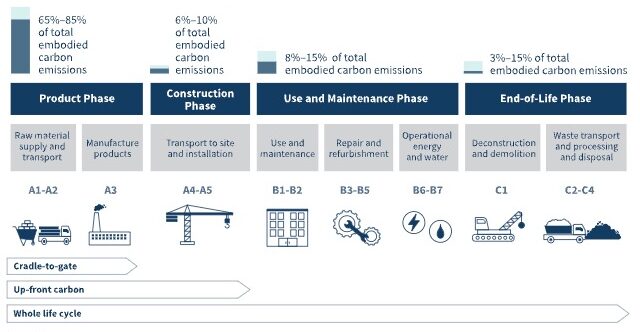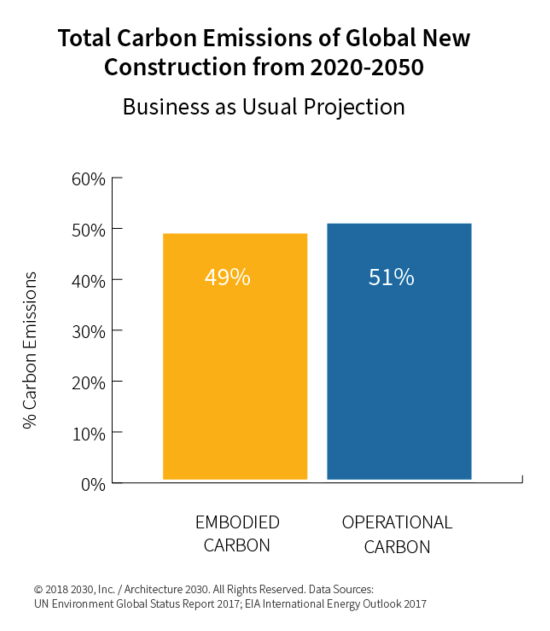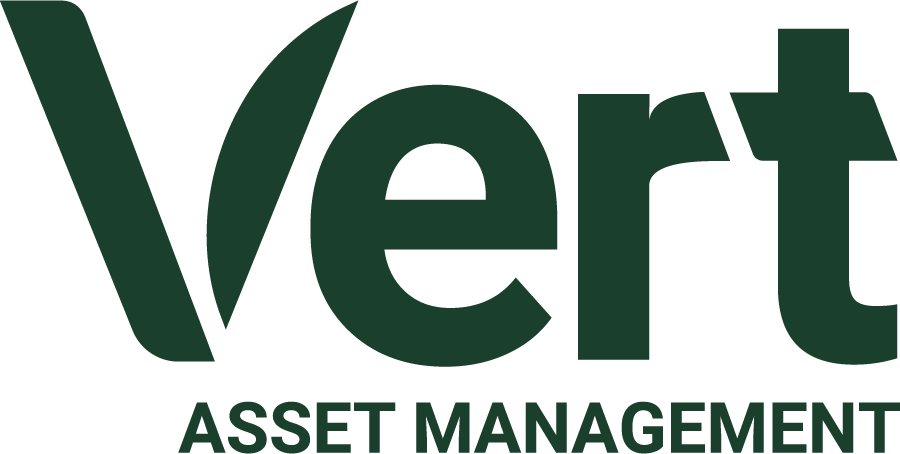Spotlight
What is Embodied Carbon?
September 2023
By Vert Asset Management and
Muzhen Shen, Sustainable Finance Researcher
What is Embodied Carbon?
Buildings generate 39% of annual global greenhouse gas (GHG) emissions. The majority of those emissions – specifically 28% – come from the buildings’ energy use. This is called “operational carbon”. These emissions arise in the normal course of operating the building – the energy used to heat and cool the building, and to keep the lights on.
The remainder of the buildings’ emissions is much less talked about. That other 11% of emissions attributed to buildings come from the materials used to construct or renovate the buildings – this is called “embodied carbon”.
Unlike operational carbon emissions which can be reduced over time with energy efficiency retrofits and procuring renewable energy, embodied carbon emissions are locked in place as soon as the construction or renovation is complete.1 The optimal time to evaluate embodied carbon reductions is during the design phase before new construction or retrofitting begins.
Whole-Building Life Cycle
To better understand embodied carbon, you have to think of a building through the “whole-building life cycle.” There are four phases: 1) product phase, 2) construction phase, 3) the use and maintenance phase, and 4) the end-of-life phase.
Embodied carbon consists of all the GHG emissions associated with building construction, including those that arise from extracting, transporting, manufacturing, and installing building materials on site, as well as the operational and end-of-life emissions associated with those materials.
“Cradle to gate” embodied carbon refers to the emissions associated with only the production of building materials, from raw material extraction to the manufacturing of finished products. It can be thought of as supply-chain carbon, and it accounts for the majority of a building’s total embodied carbon. As such it has the greatest opportunity for abatement.
Figure 1: Life Cycle Assessment Phases

Reducing Embodied Carbon
with the Circular Economy
Operational carbon can continually be reduced as technological advances such as LED lighting and heat pumps increase efficiency of energy use in buildings. More renewable energy procurement by the local grid will also drive reductions in operational emissions. As these greener technologies advance, embodied carbon emissions are expected to become a larger part of the annual global GHG emissions from the real estate sector over time. There will be more attention on materials used and the concept of the “circular economy”.2
The UN Economic Status Report estimates that in the next 30 years 50% of a building’s emissions will be attributed to building materials and the construction process.3
Figure 2: Total Carbon Emissions of Global New Construction from 2020-2050

The “circular economy” focuses on reducing the use of new primary resources by replacing the “linear” model of extraction and disposal with a “closed-loop economy”. In these systems, waste materials are recycled and become inputs to create new products.4
In real estate and building development the circular economy concept urges more attention be paid to how materials are re-used and recycled, how materials are disposed of and removed from the building site. But it also focuses on how materials are manufactured in the first instance, what the building design calls for and the overall building process. Procuring low carbon concrete, steel and façade (glass, aluminum) may have the most meaningful impact to reduce embodied carbon in the property sector.
Tools to Measure and Report on Embodied Carbon
There are a handful of tools that building owners use to understand the whole building life cycle. One Click LCA (Life Cycle Analysis), Cerclos’s eTool, and the Embodied Carbon in Construction Calculator (EC3) tool developed by the Carbon Leadership Forum. These tools help building owners, architects, and project managers, make informed judgments about material procurement based on EPDs (Environmental Product Declarations). EC3 for example makes thousands of digital EPDs available in an open-source database so that users can compare products within the same product or material category alongside the energy performance criteria.5
Green building certifications also ask about the composition of materials used in design and construction. LEED and BREEAM cover embodied carbon concepts in their respective “materials” assessment. However, at this point in time, satisfying these elements are not required to receive the final certification.
REITs Evaluating Embodied Carbon
Though the conversation around embodied carbon is still early days, a handful of REITs are taking a leadership position and starting to set targets and publicly disclose how they are evaluating embodied carbon reductions. Here are a couple examples:
DOWNLOAD
Explore more insights.

Mirvac
Australia | Diversified
Mirvac6,7 set out a strategy document Net Positive Carbon by 2030: Mirvac’s Scope 3 Emission Target and Approach.
They focus on four strategies:
- Conduct life-cycle assessments on projects at the design stage.
- Dematerialize – use higher strength products and less of it.
- Use lower carbon concrete, aluminum and steel.
- Retain the structure of the original building where feasible.
Example: Locomotive Shed in Sydney Australia retained the original structure reducing overall construction waste.

Kilroy
US | Diversified
Since 2019, Kilroy8,,9 evaluates the role of embodied carbon in development projects. They use the Embodied Carbon in Construction Calculator (EC3).
This exercise informed them that while concrete, structural steel and insulation have some of the highest embodied carbon of any construction materials, they also have the most options in terms of viable sustainable replacements. These replacements can contribute to a large reduction in embodied carbon throughout the entire life cycle of the building.
Kilroy set a goal to reduce the embodied carbon of construction materials 30% by 2030, and 50% by 2050.
Example: Oyster Point in San Francisco, California US will reduce its embodied carbon 18% by selecting carbon-intensive structural materials such as concrete, steel and metal that are regionally sourced and recycled.

Derwent London
UK | Office
In 2020, Derwent London10,11 started to set embodied carbon targets as a guide for their design teams and new commercial office buildings from 2025.
Created a “Responsible Development Framework” for new builds and renovations.
Created an Embodied Carbon Assessment to outline their approach to embodied carbon measurements for the product
and construction phases.
Derwent conducted a feasibility study on the potential of re-using structural steel in its original form (rather than melting it down and re-casting it). Unfortunately, they concluded that benefit of reusing the existing material was outweighed by complexities involved in demolition. In this case, the infrastructure of the ‘circular economy’ was not advanced enough to re-use the existing steel.
Example: 80 Charlotte Street in London retained and re-used a significant proportion of the existing building, including the majority of the structural frames and the facades.
1 EC3. (nd). “EC3 User Guide”. Building Transparency. https://www.buildingtransparency.org/ec3-resources/ec3-user-guide
2 McKinsey. (2020 September 15). “Data to the Rescue, Embodied Carbon in Buildings and the Urgency of Now.” McKinsey. https://www.mckinsey.com/capabilities/operations/our-insights/data-to-the-rescue-embodied-carbon-in-buildings-and-the-urgency-of-now
3 CarbonCure. (2022 January 19). “Everything You Need to Know About Embodied Carbon.” CarbonCure. https://www.carboncure.com/concrete-corner/everything-you-need-to-know-about-embodied-carbon/
4 Ghufran, M. et al. (2022 July 13). “Circular Economy in the Construction Industry: A Step Towards Sustainable Development.” Buildings. https://www.mdpi.com/2075-5309/12/7/1004.
5 EC3. (nd). “EC3 User Guide”. Building Transparency. https://www.buildingtransparency.org/ec3-resources/ec3-user-guide
6 Mirvac is 0.79% of the Vert Global Sustainable Real Estate Fund (VGSRX) as of June 30, 2023.
7 Mirvac. (2022). “Net Positive Carbon by 2030: Mirvac’s Scope 3 Emission Target and Approach.” Mirvac. https://mirvac-cdn-prd.azureedge.net/-/media/Project/Mirvac/Corporate/Main-Site/Corporate-Theme/images/Sustainability/Performance/3353_Mirvac_Carbon-Report_Final-for-publication.pdf?la=en&hash=C097FC06ABE170F27578E9C74AF7D09BD27AAC83
8 Kilroy is 0.43% of the Vert Global Sustainable Real Estate Fund (VGSRX) as of June 30, 2023.
9 Kilroy. (2022). “Kilroy Sustainability Report 2021.” Kilroy. https://kilroyrealty.com/wp-content/uploads/2022/04/2021-Kilroy_Sustainability_Report.pdf
10 Derwent London is 0.35% of the Vert Global Sustainable Real Estate Fund (VGSRX) as of June 30, 2023.
11 Derwent London. (2022). “Responsible Development Framework”. Derwent London. https://www.derwentlondon.com/uploads/downloads/Responsibility/Derwent_London_Embodied_Carbon_Assessment_-Nov_2020r2.pdf
The Vert Global Sustainable Real Estate Fund holds publicly traded REITs.
